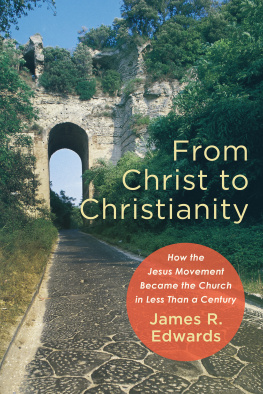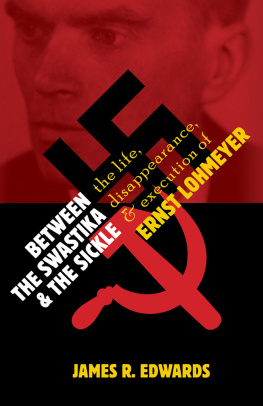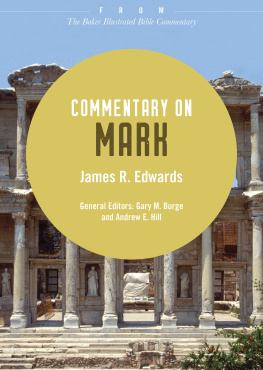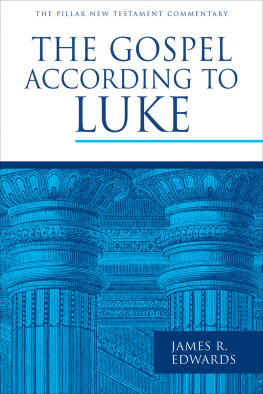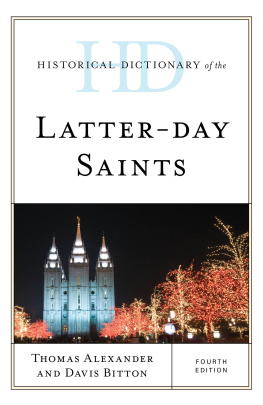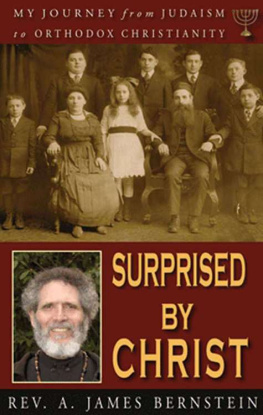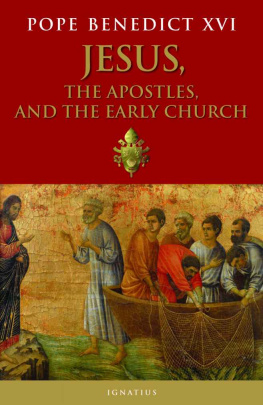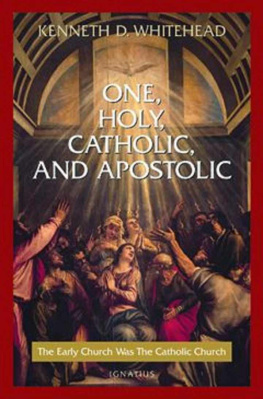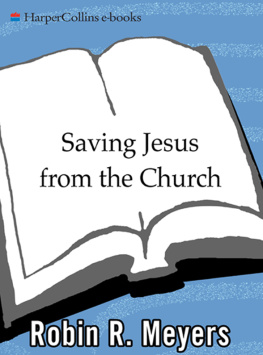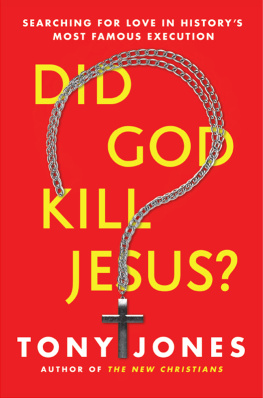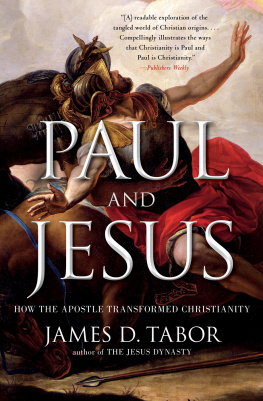Endorsements
Within a period of about seventy-five years, a small group of followers of Jesus became a major religious movement that thrived within its challenging context. Edwards looks at the many factors that contributed to this radical transformation. He convincingly shows that this periodoften seen as a hazy and undefined periodwas the most dynamic that Christianity has ever seen. This volume will be enlightening reading for anyone interested in Jesus, Paul, and what became the Christian church.
Stanley E . Porter , McMaster Divinity College, Ontario, Canada
Edwards is an adept guide to the tectonic shifts that gave rise to the now-familiar features of Christian faith; he makes a compelling case for the striking metamorphosis the early church underwent in its infancy. Yet while this books domain is the past, its stakes are in the future. At the same time that he undoes assumptions about the given forms of Christian faith, Edwards witnesses to the surprising power of the gospel to take seed and bear new fruit. Written at the cusp of a post-Christendom, postmodern, and post-Covid era of great change, From Christ to Christianity is a welcome and instructive reminder of the enduring changelessness of the gospel through the vicissitudes of time.
Amy J. Erickson , St. Marks National Theological Centre, Barton, Australia
Scholars have thoroughly worked the ground of the apostolic period, almost turning it into fine dust. That same thoroughness predominates once we arrive at the end of the second century. But the post-apostolic period has suffered relative scholarly neglect. It seems a strange world, as evidenced, for example, by the writings of Ignatius. Edwardss book fills in the empty space as no other has done. He traces the dramatic changes that occurred in the Christian movement from the close of the apostolic period to the year 140 or so: from Jewish to Gentile, from Hebrew to Greek, from rural to urban, from scroll to codex, from Sabbath to Sunday, and so much more. And yet, in spite of these dramatic changes, he shows the continuity that prevailed, too. It is clearly the same faith. The fruit looks much riper; but it is still the same fruit. Edwards knows the literature, writes with precision, and makes the story come alive. He is a master of writing engaging narrative without sacrificing accuracy and good judgment.
Gerald L. Sittser , Whitworth University (emeritus); author of Resilient Faith: How the Early Christian Third Way Changed the World
In this absorbing work, Edwards, in mastery of a wealth of ancient materials, traces how the small, rural movement of followers of Jesus in Galilee became, in less than a century, an expansive network of churches throughout the great urban centers of the Roman Empire and in regions far beyond. Edwardss work demonstrates both meticulous historical research and judicious theological conclusions, singularly marked by an unwavering attendance to the truth that it was the proclamation and exaltation of Jesus as Lord, and a Christology in correspondence to that witness and worship, that remained at the center of the church amid all ensuing changes. In writing on the New Testament and the Apostolic Fathers, Edwards demonstrates that which J. B. Lightfoot, his predecessor in this task, lifted up as the ideal for such work: The highest reason and the fullest faith. This work embodies this ideal, and as such it will be a gift not only to students of the history of Christianity but also to the church at large.
Kimlyn J. Bender , George W. Truett Theological Seminary, Baylor University
For such a time as this.... As epochal changes in our world challenge the Christian movement to seek deeper transformation than it has experienced in centuries, Edwards invites us to learn from the amazing changes that took place in the movements first seventy-five years of life. With careful scholarship and communicative skills honed by a lifetime in podium and pulpit, Edwards shows how the movement centered in the person and work of Jesus Christ adapted almost all of its forms while preserving its essential message.
Stanley D. Slade , American Baptist International Ministries
This study takes up the question of what transpired within the seventy-five-year period between the death of Jesus and the death of Ignatius to account for the strikingly creative transitions that shaped the churchs evolving self-identity. Sharing an affinity with Lohmeyers depiction of the church as marked by unchanging essence amid changing forms, adaptive to culture but not captive to culture, Edward pinpoints and fleshes out fourteen facets of the emerging church in which that insight seems most clearly evident. Readers hungry for a thorough, rigorously well-researched, astutely analytical study that is meticulous in scholarly details while not overreaching about historical lacunas where literary evidence is scant will be amply rewarded. His writing style is both erudite and elegant.
Jeannine M. Graham , George Fox University (emerita)
Title Page
Copyright Page
2021 by James R. Edwards
Published by Baker Academic
a division of Baker Publishing Group
PO Box 6287, Grand Rapids, MI 49516-6287
www.bakeracademic.com
Ebook edition created 2021
All rights reserved. No part of this publication may be reproduced, stored in a retrieval system, or transmitted in any form or by any meansfor example, electronic, photocopy, recordingwithout the prior written permission of the publisher. The only exception is brief quotations in printed reviews.
Library of Congress Cataloging-in-Publication Data is on file at the Library of Congress, Washington, DC.
ISBN 978-1-4934-2021-6
Unless otherwise indicated, translations of Scripture are the authors own.
Scripture quotations labeled ESV are from The Holy Bible, English Standard Version (ESV), copyright 2001 by Crossway, a publishing ministry of Good News Publishers. Used by permission. All rights reserved. ESV Text Edition: 2016
Scripture quotations labeled NIV are from THE HOLY BIBLE, NEW INTERNATIONAL VERSION, NIV Copyright 1973, 1978, 1984, 2011 by Biblica, Inc. Used by permission. All rights reserved worldwide.
Scripture quotations labeled RSV are from the Revised Standard Version of the Bible, copyright 1946, 1952 [2nd edition, 1971] National Council of the Churches of Christ in the United States of America. Used by permission. All rights reserved worldwide.
Dedication
In grateful memory of my teachers
David Dilworth
Bruce M. Metzger
Eduard Schweizer
Ralph P. Martin
Martin Hengel
Contents
Cover
Endorsements
Title Page
Copyright Page
Dedication
Preface
Abbreviations
Maps
Introduction: Two Profiles of One Reality
1. From Rural to Urban
2. From Jerusalem to Rome
3. From Jerusalem to the East and South
4. From Hebrew to Greek
5. From Jesus Movement to Gentile Mission
6. From Jesus Movement to Roman Persecution
7. From Torah to Kerygma
8. From Synagogue to Church
9. From Jewish to Christian Ethos
10. From Passover to Eucharist
11. From Apostles to Bishops
12. From Sabbath to Sunday
13. From Way to Christian
14. From Scroll to Codex
Conclusion: New Wine in New Wineskins
Bibliography
Scripture Index
Ancient Writings Index
Subject Index
Back Cover
Preface
The number and variety of resources for understanding the New Testamentcommentaries, word studies, lexica of ancient languages, theological dictionaries, comparative studies of Judaism and Hellenism, and specialized studies in the history, sociology, culture, and archaeology of the first Christian centurymake the study of the New Testament a veritable oasis for layperson and scholar alike. I have been privileged to spend the greater part of my professional and scholarly life in this oasis.

